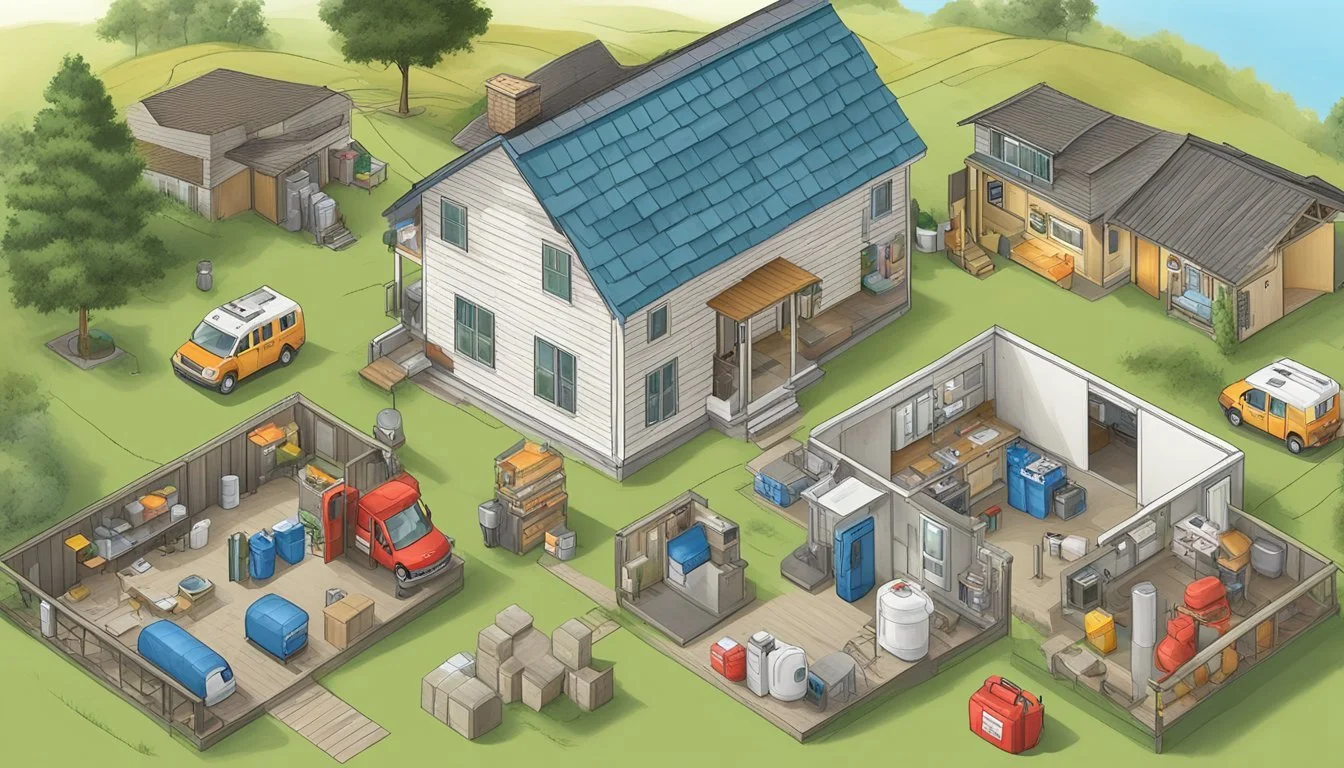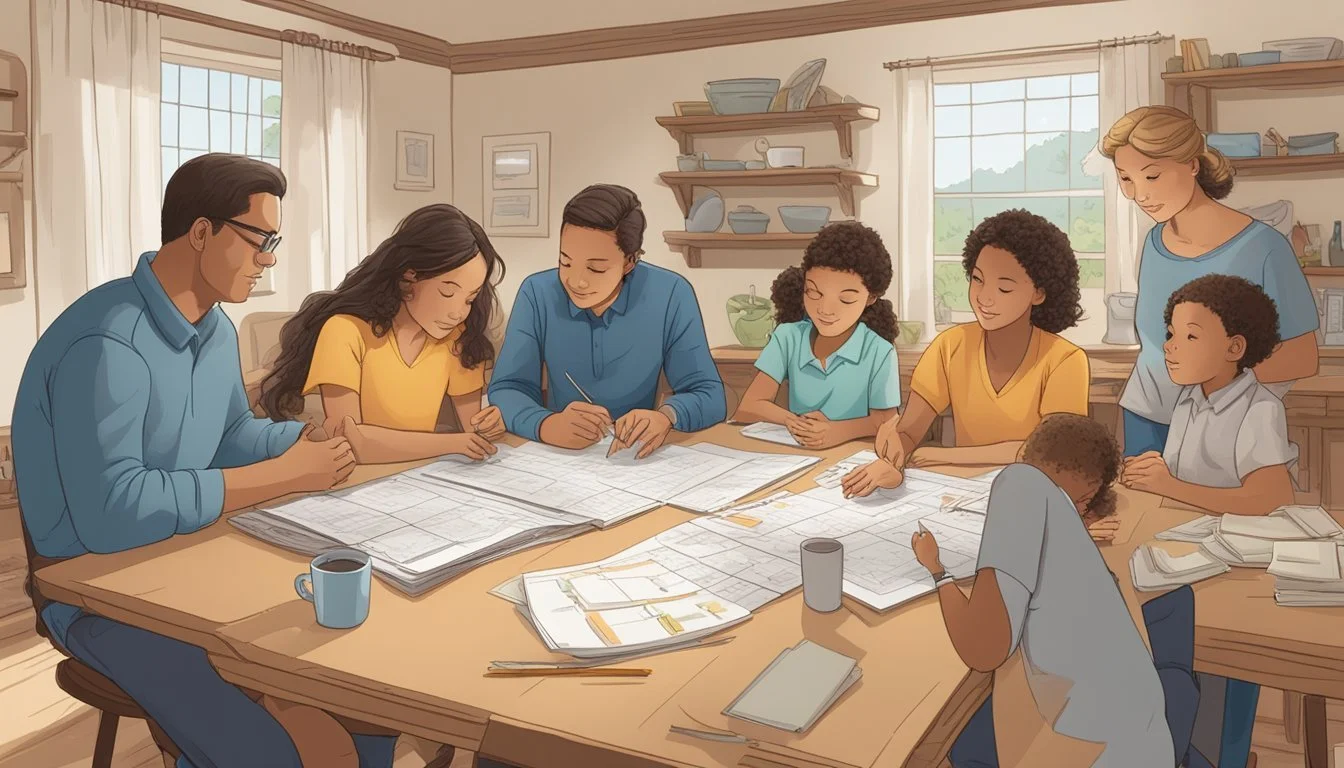How to Create a Homestead Emergency Preparedness Plan
Essential Steps for Safety
Creating a homestead emergency preparedness plan is a crucial step in ensuring the safety and sustainability of your property and loved ones during unforeseen disasters. Such a plan outlines necessary actions for various emergencies, detailing how to respond swiftly and effectively. Homesteading presents unique challenges due to its often remote location, reliance on self-sufficiency, and the variety of tasks and animals that may require protection and care.
A comprehensive emergency plan for a homestead starts with assessing potential risks, such as natural disasters specific to the region, including floods, droughts, wildfires, or severe storms. It also addresses the vital components of survival: water, food, shelter, and first aid. Planning involves not only mapping out escape routes and emergency shelters, but also incorporates sustainable practices to ensure a reliable water source, food stockpile, and the safety of any animals on the property.
In addition, an effective plan emphasizes communication strategies, care for dependents, and the management of any business operations during crises. Keeping an emergency kit on hand, practicing evacuation drills, understanding the care of children and animals, and ensuring the continuity of daily operations are all part of making a plan tailored to one’s specific needs. By preparing in advance, homesteaders can rest assured that they have the necessary measures in place to handle emergencies with confidence.
Understanding the Basics of Homestead Emergency Preparedness
Creating a robust Homestead Emergency Preparedness Plan is essential for safeguarding life, property, and assets against unpredictable disasters. This plan must be comprehensive, addressing various potential threats that could impact a homestead.
Defining a Homestead Emergency Plan
A Homestead Emergency Plan is a systematic, detailed protocol designed to protect the inhabitants and resources of a homestead in the event of disasters. It encompasses not only immediate response strategies but also long-term support and recovery mechanisms. Such a plan takes into account the unique challenges posed by living on a homestead, including remote locations, self-sufficiency needs, and often limited access to immediate emergency services.
Identifying Potential Disasters
Homesteads can face many risks that come from both natural and human-made disasters. To best prepare, they must identify and assess these potential threats:
Natural Disasters: Depending on the location, a homestead may be prone to various natural phenomena such as earthquakes, floods, tornadoes, wildfires, and hurricanes. The impact of climate change can also exacerbate these events, making a previously safe area vulnerable.
Risks: Each type of disaster carries specific risks to the homestead. For instance, earthquakes may compromise structural integrity, floods could damage crops and buildings, and wildfires could threaten the entire homestead.
Considering each of these factors and their likelihood of occurring is a critical step in formulating an effective emergency plan.
Planning for Family and Special Needs
In an emergency, it's critical to have a plan that addresses the unique requirements of every family member, including those with special needs, and to ensure the safety of pets and livestock.
Addressing Specific Needs of Family Members
Proper preparation takes into account the diversity of needs within a family unit. For children, having age-appropriate supplies and a familiar item for comfort can ease the stress during a disruption. The elderly may require access to medication and mobility aids. Meanwhile, family members with disabilities might need additional support to evacuate or maintain routines in emergencies. It is essential to:
List each family member's special need or disability.
Assemble a personalized emergency kit for each person, including necessary medications, devices, and supplies.
For comprehensive strategies on preparing a tailored plan, Habitat for Humanity offers guidance that can be adapted to your family's needs, and Ready.gov provides easy steps to creating a family emergency plan.
Ensuring Pets and Livestock Safety
Pets and livestock represent not just property, but cherished parts of the family and require their emergency plans. To secure their safety:
Create a list of pet-friendly shelters in advance, as not all emergency shelters accept animals.
Prepare an animal emergency kit containing food, water, medications, and veterinary records.
Identify local animal shelters where livestock could be temporarily housed.
Practice evacuation procedures for livestock to reduce chaos during an actual event.
For practical advice on preparing for pets, the Red Cross provides resources on disaster preparedness that includes pet safety. Additionally, consider the FEMA guidelines for people with disabilities and other special needs that also touch upon pet care in emergencies.
Setting Up Communication Plans
In an emergency, the ability to communicate effectively can be crucial for the safety and well-being of a homestead. Setting up comprehensive communication plans ensures that residents know how to reach out for help and stay connected with family members or emergency contacts, especially in scenarios where they might be separated.
Establishing Emergency Contact Information
One must compile a list of emergency contacts, including local emergency services, medical facilities, and family members who can assist during a disaster. This list should be accessible to all household members and include the following details in a clear format:
Full Name
Relationship
Primary Phone Number
Alternate Phone Number
Email Address
It is advised to keep a printed copy of this contact information in various locations, such as in one’s emergency kit, in vehicle glove compartments, and in children’s backpacks. Additionally, storing these contacts in cell phones and other electronic devices ensures the information is easily accessible when needed.
Creating a Communication Plan for Separation Scenarios
Homesteads should prepare for situations where household members are separated during an emergency. Strategies include:
Designate a primary contact person outside the immediate area who can relay messages between family members if local communication infrastructure fails.
Agree upon a predetermined meeting place that is familiar and easy to find.
Use technology to stay in touch, encouraging all members to carry a charged cell phone with pre-loaded emergency contact information.
The plan should outline clear instructions for both initiating and receiving a phone call in case of separation. Explicitly articulate who to contact first, and the order of contact numbers to try subsequently if the primary contact is unreachable. This plan will aid in reuniting separated individuals swiftly and safely.
Developing Evacuation Procedures
Creating a homestead emergency preparedness plan involves establishing clear and practical evacuation procedures. This process ensures that when every second counts, family members can respond rapidly and safely.
Outlining Evacuation Routes
One must identify multiple evacuation routes from their homestead as well as from frequent destinations such as the workplace. These routes should be clearly mapped, taking into consideration the most direct paths and potential obstacles. Additionally, one should consider:
Primary and secondary routes from both the homestead and workplace to avoid congestion and blockages.
Various modes of transportation, evaluating the viability of using vehicles or going on foot if roads are impassable.
Alternate routes in case the primary paths are compromised due to the emergency.
It's advisable to prepare detailed maps and have physical copies within easy reach of all potential evacuees.
Practicing Evacuation with Family Members
Conducting regular practice drills is essential for ensuring that all family members are comfortable with the evacuation plan. Practice should:
Include moving to identified meeting places, ensuring all members understand their locations and the importance of getting there promptly.
Involve using different vehicles to familiarize drivers with the evacuation process under various scenarios.
Be conducted at different times of the day and year to account for varying conditions such as darkness or severe weather.
Through consistent practice, the act of evacuation will become an ingrained response, thereby enhancing the safety of all family members should an actual emergency arise.
Organizing Emergency Supplies and Kits
Effective management of emergency supplies and kits is a cornerstone of a successful homestead emergency preparedness plan. It ensures quick access and efficient use of resources during times of need.
Assembling an Emergency Kit
An emergency kit acts as the first line of defense in a crisis. It should include a range of essential supplies that cater to basic needs. They must have a comprehensive first aid kit, necessary medications, and multi-purpose tools. Hygiene items are also crucial, as they maintain good health and prevent the spread of disease.
Critical Items for an Emergency Kit:
First Aid Supplies: bandages, antiseptics, pain relievers
Tools: flashlight, batteries, multi-tool, manual can opener
Communication: hand-crank or battery-powered radio
Protection: space blankets, weather-appropriate clothing
Storing Sufficient Water and Food Supplies
One of the most critical aspects of preparedness is ensuring adequate water and food supplies are on hand. A rule of thumb is to store at least one gallon of water per person per day for drinking and sanitation. For food, a combination of non-perishable food items that require minimal preparation is recommended.
Guidelines for Water and Food Storage:
Water: One gallon per person per day; store in clean, food-grade containers.
Food: A mix of canned goods, dried legumes, nuts, and other high-energy foods; select items with long shelf lives.
In organizing these emergency supplies, they must be in a secure, accessible location. Rotate supplies to keep them fresh, and ensure that all family members are aware of the storage site. Proper storage reduces the risk of spoilage and assists in maintaining an organized response should an emergency arise.
Maintaining Safety and Health
In the event of a home emergency, immediate attention to the safety and health concerns is crucial. Shelter and warmth are non-negotiable to ensure survival, while efficient management of health needs and medication is essential for maintaining well-being during crises.
Securing Shelter and Warmth
One must assess the integrity of their housing structure for safe shelter in place during an emergency. It includes checking for stability and the absence of harmful debris. In cold climates, maintaining warmth is vital; this can entail insulating windows, having an array of thermal blankets, and possessing a reliable heat source that does not require electricity. For instance, a fireplace or a wood stove can be invaluable.
Safe Areas: Identify the safest areas in your home that offer protection against natural disasters.
Personal Hygiene Items: Stockpile necessary items such as soap, hand sanitizer, and wet wipes to promote cleanliness and disease prevention.
Managing Health and Medications
A well-stocked first aid kit is essential, including bandages, antiseptics, and tools for minor medical procedures. Individuals should have a clear inventory of required medications, ensuring a supply that lasts for at least 72 hours. Proper storage of these medications is paramount, considering temperature-sensitive drugs may be compromised without power.
Medication: Keep a list of prescriptions, dosage instructions, and potential allergies with your emergency kit.
First Aid Kit: Regularly check expiration dates and replenish supplies as needed to keep the kit ready for immediate use.
Preparing for Power and Utility Disruptions
Disruptions in power and utilities are a critical concern for homesteaders, calling for strategic planning to manage without electricity and gas, and the safe utilization of generators and alternate power sources.
Managing Without Electricity and Gas
In the absence of electricity, one should plan to meet essential needs like heating, cooking, and lighting. Storing a sufficient supply of heating fuels such as wood for a masonry heater or propane for gas heaters is pivotal. For cooking, homesteaders should consider outdoor grills or camp stoves utilizing charcoal or propane. Safe, rechargeable battery-powered lights or candles can address lighting needs.
Considerations for Using Generators and Alternate Power Sources
When considering a generator, recognize that it should match the essential appliances you intend to power during an outage. Calculate the wattage needs of these devices and select a generator with a higher output. Carbon monoxide safety is paramount; hence, generators should only be used outdoors and away from windows. Exploring alternative sources like solar panels or wind turbines can provide sustainable electricity, but require an initial investment and understanding of how to integrate them into the existing electrical system.
For securing food during outages, one technique is making ice ahead of time to keep perishables cold. One's preparedness kit should also include a plan for safe generator operation disclosed by Mother Earth News. Having a thermal cooker or wood stove is another tactic suggested by Homesteading Family for meals without relying on a steady supply of power.
Planning carefully for these situations ensures safety and sustainability during unexpected power outages.
Staying Informed During Emergencies
In the realm of homestead emergency preparedness, staying apprised of evolving situations is vital. Knowing how to access real-time alerts and information can make a significant difference in response actions.
Accessing Emergency Alerts and Information
Homesteaders should prioritize the setup of systems to receive emergency alerts. A key component is signing up for local emergency notifications, which can often be done through a local government website. These alerts provide timely information specific to one's immediate area. In addition, mobile devices now typically have the capability to receive Wireless Emergency Alerts (WEAs) that inform residents of severe weather, missing persons, and other critical situations.
Utilizing NOAA Weather Radios and Other News Sources
A NOAA Weather Radio (NWR) is an essential tool for receiving continuous weather information directly from the nearest National Weather Service office. NWR broadcasts official warnings, watches, forecasts, and other hazard information 24/7. Aside from radio, one should also consider other reliable news sources including local TV stations and reputable online news outlets. It's essential for individuals to have a battery-powered or hand-crank radio on hand, in case of a power outage, to maintain access to information via these channels.
Reviewing and Updating Your Preparedness Plan
A homestead emergency preparedness plan must be dynamic, adapting as circumstances evolve. Regularly scheduled reviews ensure that the plan remains relevant and effective for a family's safety.
Conducting Regular Plan Reviews
They should schedule plan reviews at least twice a year, marking them on the calendar as a vital task. During these reviews, homesteaders must:
Verify that contact information for all family members and local emergency services is current.
Reevaluate risks based on any recent changes in the homestead or community.
Confirm if important documents are up-to-date and securely stored.
Practice the execution of the plan to identify any new challenges or potential oversights.
Incorporating New Information and Changes
Changes in the homestead or family structure necessitate updates to the emergency preparedness plan. When incorporating new information or changes, one should:
Assess the impact of new risks or elimination of old ones and adjust accordingly.
Update the communication plan to reflect any new devices, platforms, or protocols.
Integrate any new methods or guidelines gathered from recent training, drills, or experiences.
Review and include additional important documents, revising inventory lists to reflect new assets or resources.
Documenting and Protecting Important Information
For a homestead emergency preparedness plan, the protection and accessibility of important documents and contact information are crucial. They ensure that individuals can swiftly recover and get in touch with essential services and personal contacts following an emergency event.
Securing Important Documents and Contact Info
It is imperative to keep important documents such as birth certificates, property deeds, insurance policies, and passports in a secure location. A fireproof and water-resistant document bag provides an excellent method for organizing these crucial items on a homestead. Such a bag can accommodate binders and can store other essential items like keys or USB drives which may contain digital copies of these documents.
Alongside physical documents, maintaining a detailed contact list is essential. This list should include numbers for emergency services, family, friends, and local shelters. Ensure that this list is readily accessible and stored in multiple secure locations.
Creating Copies and Digital Backups
The creation of both physical and digital copies of critical documents safeguards against the loss of the originals. Printed copies should be stored in separate secure locations, while digital backups can be housed on cloud storage services or external hard drives. These digital copies enable quick retrieval from any location with internet access, increasing resiliency in the face of a disaster.
Homesteaders should consider utilizing a digital library to keep a comprehensive backup of important files. By scanning documents and storing them electronically, they secure an additional layer of protection and ensure the continuity of access to necessary information after an emergency unfolds.
Considering Homestead-Specific Preparations
Creating a homestead emergency preparedness plan requires consideration of unique aspects, such as safeguarding gardens and crops, as well as ensuring the well-being of livestock.
Protecting Gardens and Crops
Assessing Risk: Identify potential threats to garden and crop areas specific to your region. Actions include creating a disaster kit with tools and resources to mitigate damage.
Install protective structures (e.g., hail nets, row covers)
Maintain an emergency supply of water and manual tools for sustained crop care
For further guidance, reading about making a homestead evacuation plan can offer additional strategies.
Caring for Livestock and Wildlife
Shelter and Safety: Ensure that structures housing livestock are secure and can withstand extreme weather events. Prepare for their evacuation if necessary.
Designate emergency livestock shelters
Prepare an emergency feed and water supply
It is also recommended to explore insights on disaster preparedness for homesteaders, which detail requirements for water and feed during emergencies.
Dealing with Post-Disaster Scenarios
After a disaster strikes, the focus quickly shifts to addressing the immediate aftermath. A solid emergency preparedness plan includes strategies for reuniting with family and community, as well as assessing and repairing any damage to the homestead. Being prepared can help to alleviate the chaos and provide a clearer path to recovery.
Reuniting with Family and Community
When disaster separates individuals from their loved ones, reestablishing contact is paramount. Unfortunately, traditional communication networks are often disrupted, thus, one should have alternative methods in place. Strategies include:
Designating Meeting Areas: Have predetermined locations where family members can gather if returning home is not an option.
Updating Contact Lists: Maintain an up-to-date list of contact information for all family members and local emergency services. Distribute physical and digital copies to all relatives.
Utilizing Community Resources: Engage with community emergency plans, shelters, and resource centers, which may assist in reuniting separated families.
Assessing and Repairing Damage to the Homestead
Once it's safe, a thorough evaluation of the homestead is crucial for prompt and efficient repair. One should:
Inspect the Integrity of Buildings: Check for structural weaknesses, gas leaks, or electrical hazards. Employ professionals if necessary; safety is the top priority.
Catalog Damages: Compile a detailed inventory of damages to buildings, land, and personal property for insurance claims and repair plans.
Prioritize Repairs: Focus on repairs that prevent further damage or restore basic utilities, like water and electricity.
Utilizing resources such as home emergency preparedness plans and post-disaster recovery planning guides can provide templates and checklists to ensure a comprehensive approach to dealing with post-disaster scenarios.
Supporting Resources and Assistance
In crafting a homestead emergency preparedness plan, it is critical to incorporate external support systems that can offer assistance and resources during an emergency situation. Homesteaders should be familiar with available government services, community support, and educational material that can enhance their readiness.
Utilizing FEMA and Local Emergency Services
Homesteaders should establish a connection with the Federal Emergency Management Agency (FEMA), which provides comprehensive guidance on emergency planning, such as their development guide for emergency operations plans. Being informed about local emergency services is also imperative. Residents should sign up for emergency alerts in their area to receive real-time notifications about imminent threats and advisories.
Accessing Community and Online Resources
Building a network of community resources can offer valuable support during a disaster. This could include local shelters, healthcare facilities, and mutual aid groups. Additionally, online resources present an extensive array of information for emergency preparedness. Homesteaders can find detailed plans and checklists online, such as those provided by the Red Cross, to ensure they are comprehensively prepared.
Training and Educational Opportunities
Homestead emergency preparedness requires solid knowledge and skills. It's crucial for individuals to seek training and educational opportunities to ensure they are fully prepared for any situation.
Participating in Local Emergency Preparedness Workshops
Local emergency preparedness workshops provide practical, hands-on training. These workshops enable attendees to learn from experts about specific preparedness strategies, practice essential skills in a supportive environment, and access valuable educational materials. The FEMA website outlines various in-person training opportunities that cover a wide range of topics, including incident management and mass casualty response.
Finding Online Courses and Guides
For those unable to attend local workshops, online courses and guides offer flexible learning opportunities. These online resources often include comprehensive emergency preparedness material, which users can study at their own pace. Websites like Ready.gov provide modular emergency preparedness curricula, designed to educate on creating emergency kits and family communication plans, while also being geared for both adults and children.











